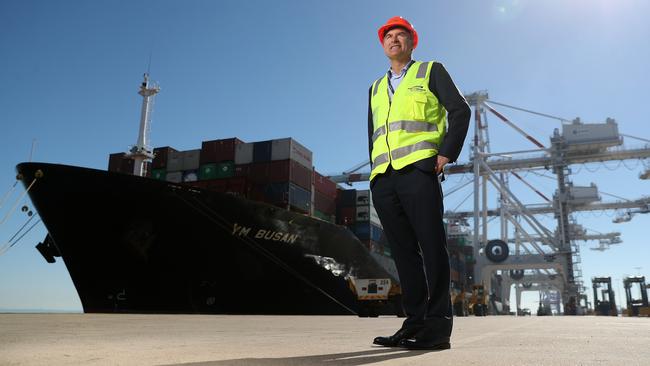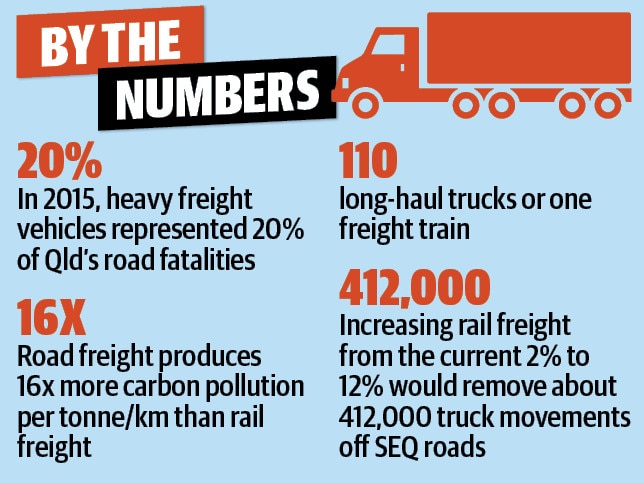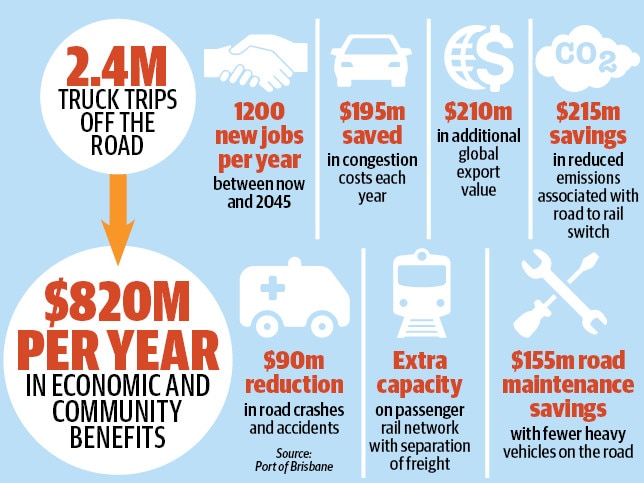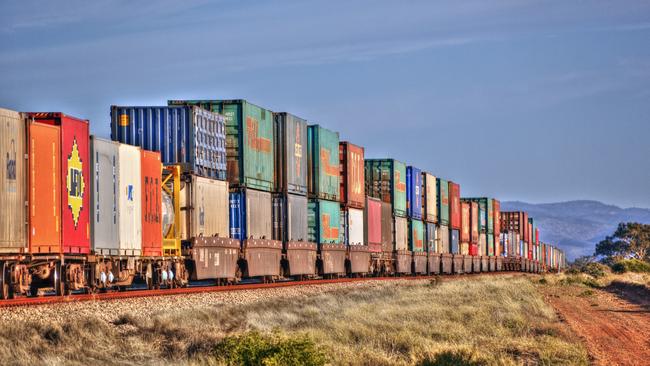Brisbane facing ‘tsunami of trucks’ unless dedicated freight rail line built
Brisbane’s roads face being choked by millions more truck trips each year unless a crucial piece of infrastructure is built, a new report has found.
QLD News
Don't miss out on the headlines from QLD News. Followed categories will be added to My News.
BRISBANE faces a “tsunami of trucks” — with an extra 2.4 million big-rig trips on our roads each year — unless a dedicated freight rail line is built to the city’s busting port.
The Sunday Mail can reveal the long-discussed missing link in the Queensland capital’s transport network would also deliver an $820 million annual economic, social and environmental dividend and create 1200 jobs a year.
These are the findings of a comprehensive report conducted for the Port of Brisbane by consultants Deloitte which found the current freight system was forcing tens of thousands of additional trucks onto Brisbane’s roads.
The concept of linking the multi-model freight hub at Acacia Ridge in the city’s south to the privatised port in the east through a dedicated freight line has been the subject of numerous studies, modelling and investigations for a generation.
Inland Rail needed to save declining train industry
Inland Rail: Farmers, rural communities becoming hostile towards project
Logan concerns as Inland Rail map reveals investigation zone

Crucially, the link would realise the full benefits of the transformative 1700km Melbourne to Brisbane Inland Rail project by allowing double-stacked trains to travel straight to the port, rather than being unloaded onto trucks at Acacia Ridge for the trip through the suburbs.
One recent study recommended a tunnel branching off the current interstate rail line south of Acacia Ridge to the Gateway Motorway and then an above and below ground track shadowing the motorway before veering off to the port.
Another study is currently being conducted by the Australian Rail Track Corporation and the Department of Transport and Main Roads.
The prohibitive costs and the prospect of significant resumptions has caused state and federal politicians to baulk at the project whenever it has been proposed.
However, the 115-page Deloitte investigation has found the cost of this do-nothing approach has put an economic handbrake on Brisbane by adding to congestion and road maintenance costs while causing commuters to suffer additional accidents.

According to Deloitte, just 2.5 per cent of container freight in Brisbane is currently moved by rail because the shared network gives priority to passenger services.
This compares to about 20 per cent in Sydney and Melbourne.
The study found the Inland Rail, in concert with the State Government’s Cross River Rail project would likely exacerbate rather than resolve the issues with the growing freight load certain to be moved by trucks because they were more efficient.
The Port of Brisbane has forecast its current load of 1.35 million containers a year will grow to over five million by 2050, adding 13 million truck movements annually around the city to service the need for goods from a growing population.
Port of Brisbane chief Roy Cummins said linking Inland Rail to the port through a dedicated freight line would protect the region’s liveability and prevent a “tsunami of trucks” taking over the streets.
“If we don’t directly connect Inland Rail to the Port of Brisbane, Queenslanders won’t get the jobs, but they will get the trucks,” Mr Cummins said.
“That’s because as Queensland’s population grows, so too that the freight task. The way our supply chain is established at present, that means a truck tsunami is heading our way.”
Mr Cummins called for the release of the ARTC/DTMR route study as soon as possible.
“It’s time to get behind one corridor,” he said.
“We look forward to the imminent release of the rail access study so the community, industry and government can work together on the best long-term solution.”

The Deloitte study found rail’s share of freight movements had plummeted in Brisbane from 12 per cent to 2.5 per cent over the last 16 years as peak-hour passenger services increasingly utilized the available slots on the network, forcing producers to move their goods by trucks to meet tight deadline.
“If the trend of declining rail share continues, this current share of under three per cent will get even lower over the long term,” the study said.
“This will have significant economic, social and environmental implications.”
The study revealed western Queensland container exporters had completely abandoned rail after making up 26 per cent of freight taken to the port via rail just nine years ago.
“In other words, 100 per cent of the export containers currently on rail to the Port of Brisbane are coming via the North Coast Line, in particular from Rockhampton and locations further north,” he study said.

However, despite the distance, even these exporters were turning to trucks because of the huge risk that their containers won’t reach the port in time.
“For example, of the 198 loaded intermodal container trains from central and north Queensland to the port in 2017 carrying produce for export, 34 (17 per cent) were delayed into the port by over two hours and another 69 (35 per cent) were delayed into the port by between one and two hours.”
The study found the Inland Rail project would make trains more attractive to southwestern Queensland exporters.
However, trucks would still finish the job because the cutback version of the $7 billion Cross River Rail that is being built, in concert with extra passenger services it would herald, would leave little capacity for freight.


